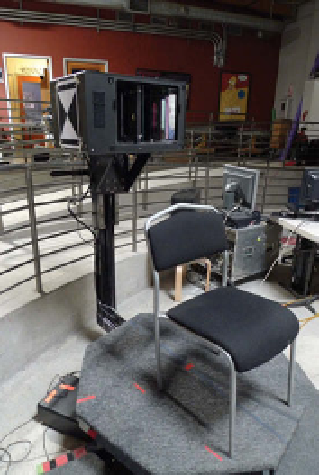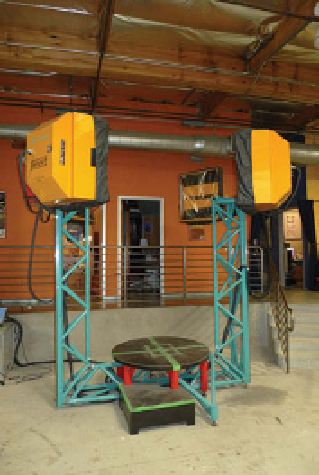Graphics Reference
In-Depth Information
in Section
8.1.1
, resulting in a shorter-range system) while others are phase-based,
using four samples of the incident waveform to estimate the phase (see Problem
8.7
).
Themain advantage of a flash LiDAR system is its speed; short-range depth images
can be generated in real time at thirty frames per second or higher. Flash LiDAR
devices are also relatively inexpensive and much easier to set up and use than pulse-
or phase-based LiDAR systems. On the other hand, there are several disadvantages
to current flash LiDAR systems in addition to the low resolution. In particular, the
measurement accuracy is quite a bit worse than either of the LiDAR technologies
discussed previously or the structured light andmulti-view stereomethods discussed
next (i.e., errors on the order of centimeters rather than millimeters). Furthermore,
the sensors may work poorly outdoors or at very close range, and typically exhibit
a systematic distance error [
244
]. Computer vision researchers have recently made
progress in applying super-resolution techniques to flash LiDAR, combiningmultiple
successive images from a moving sensor to improve the quality of each frame [
110
].
There are also several visual effects applications, such as projecting image-based
environment lighting onto a 3D object, where high accuracy in the 3Dmeasurements
isn't critical and the speed of collection is more important.
8.2
STRUCTURED LIGHT SCANNING
The best method for acquiring three-dimensional measurements of a small object —
such as a movie prop or an actor's head — is
structured light scanning
. For every
major visual effects movie, the principal actors' bodies and heads are scanned before
or during production using the types of scanners pictured in Figure
8.9
. The resulting
3D scans are used to build digital stunt doubles for actors, to aid in creating realistic
(a)
(b)
Figure 8.9.
(a) A body scanner based on structured light. The performer stands on the middle
platform as four structured-light scanners move up and down the surrounding gantry. (b) A head
scanner based on structured light. The performer sits in the chair as the gantry moves around
his or her head.




